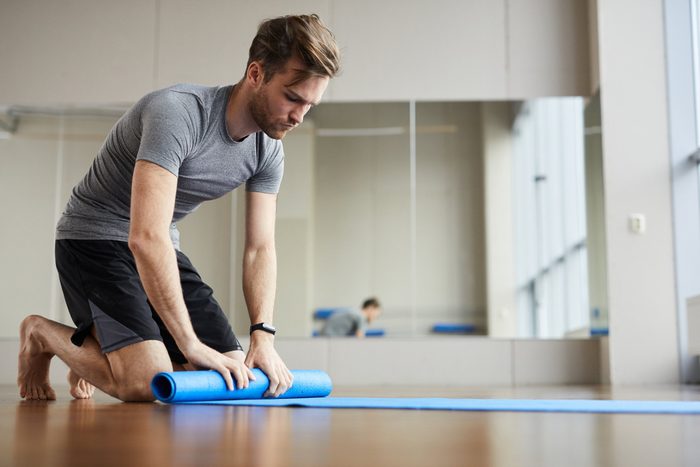
Yoga Stretches for Belly Bloating
The health benefits of yoga are by now well documented. They include reducing lower back pain and neck pain, easing depression and anxiety, aiding in weight loss and smoking cessation, as well as managing chronic diseases. A study published in 2015 in Evidence-Based Complementary and Alternative Medicine suggests that yoga may also help with bloating. Thats a problem that affects around one in three adults, according to a study published in 2019 in Advances in Therapy.
“Because so many of the different postures centre around your core, they can help bring focus to your abdomen,” says Keri Gans, RDN, registered dietitian nutritionist and certified yoga teacher in New York City and host of The Keri Report podcast. “The other thing is the de-stressing that can occur. Anything we do to decrease our stress levels is beneficial in more ways than we can understand.”
Bloating can be the result of simply breathing in too much air or a sign of something more serious like celiac disease (if it’s combined with other symptoms). If you suspect you have a medical condition that needs treatment, contact a healthcare professional, but for run-of-the-mill bloating—which affects all of us at one time or another—these yoga moves from Gans may help. (Also, check out the daily habits that can flatten your stomach.)
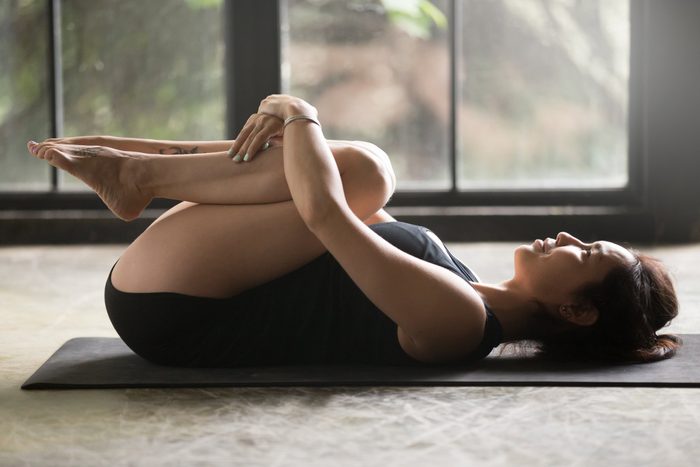
Knees-to-chest
Aptly known as “the wind-relieving pose,” this simple move delivers when it comes to relieving digestive woes. By bringing the knees to the chest—”the closer to your chest the more beneficial it may be,” says Gans—you can soothe your stomach by improving digestion to release the buildup of gas. Start by lying flat on your back, arms resting at your side. Take a deep breath in, then on your exhale bend the knees and slowly bring them up to your chest, hugging your legs into your body. From here, you can gently rock from side to side, raise your chin toward your knees, or alternate bringing your knees to your chest one leg at a time. Hold for up to one minute.
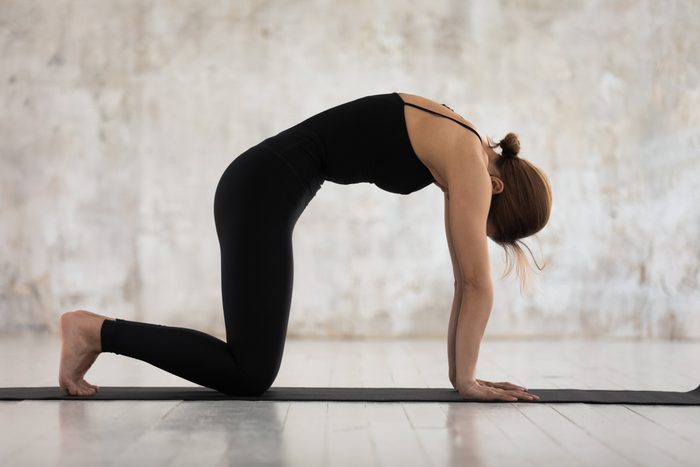
Cat/Cow
A feel-good move to relieve pressure in the back, chest, and neck, Cat/Cow works to reduce bloating by stretching and contracting the abdomen with each motion, says Gans. Start by positioning yourself on your hands and knees, keeping knees hip-width apart, and arms shoulder-width apart. As you inhale, raise your head and tailbone toward the ceiling, looking up at the sky as you bend your back. As you exhale, round the head and tailbone down, creating a deep arch with your back. Try this combo around eight to 10 times, or as needed throughout the day. (You can also try these remedies to reduce bloating.)
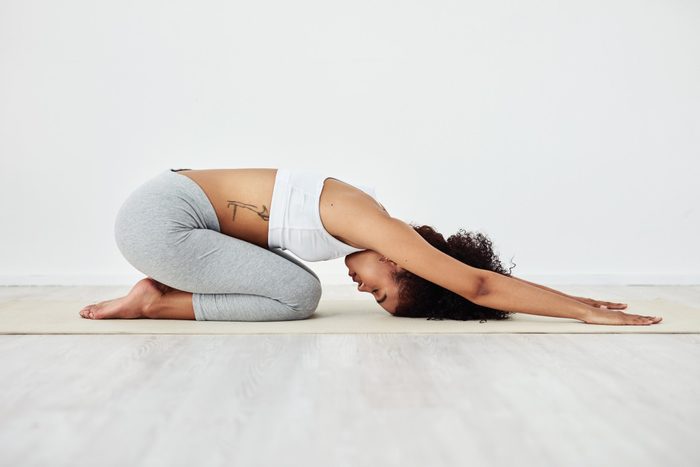
Child’s Pose
Child’s pose is known as a “grounding pose,” and one you can always come back to relieve pain associated with bloating by applying pressure to the lower abdomen. To find child’s pose, kneel on the floor, hips resting on the heels of your feet. Bending at the waist, keep arms by your side or reach them out in front of you and slowly crawl your fingers forward, stretching as far as is comfortably possible. (“If arms are by your side, it’s soothing and if they’re reached out it’s more active,” notes Gans. “Both are de-bloating.”) Once you’re settled, breath in and out for about 20 to 30 seconds, before walking yourself back into an upright position with your hands. Repeat as many times as you like.
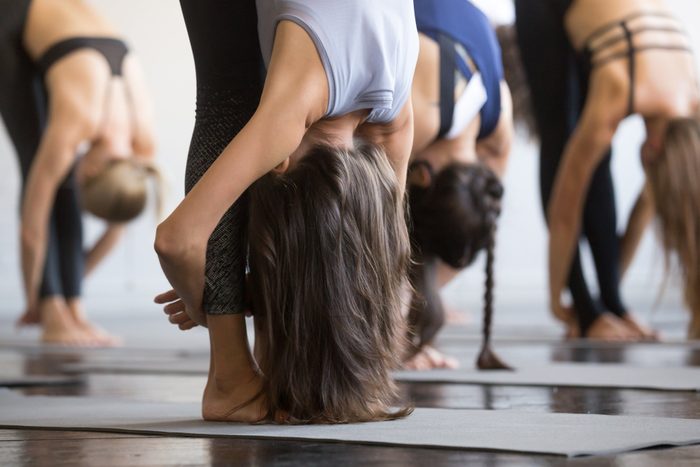
Standing Forward Fold
The Standing Forward Fold is a simple pose that works to relieve bloating by warming up the belly to promote circulation, helping those digestive juices flow. Standing upright with your hands on your hips, take a deep inhale, and as you exhale bend forward at the waist, taking care to keep a straight back and spine. “If that’s difficult feel free to bend your knees and rest your upper body on the top of your thighs,” says Gans. Depending on your flexibility, you can place your hands on the floor, behind your neck, or even just allow them to hang, swaying gently from side to side. To release, slowly roll the body back upright, taking a minute to center your breath once you reach your starting position.
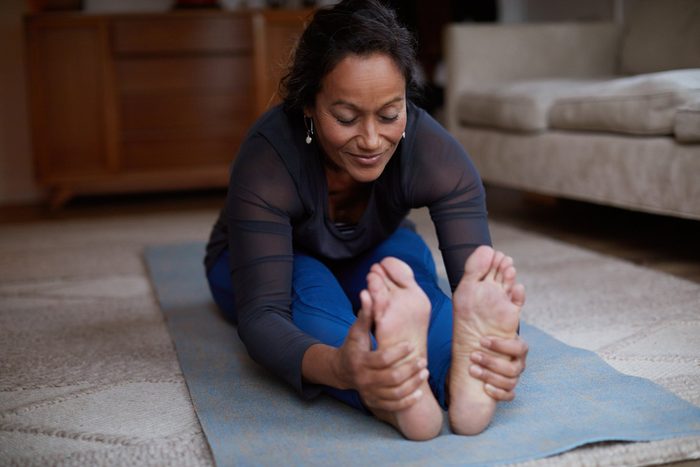
Seated Forward Fold
The deep stretch found within a Seated Forward Fend applies a lot of pressure to the abdominal muscles, diminishing discomfort with every breath. (This one does go a little deeper than the Standing Forward Fold, so try not to push too far past what feels comfortable.) Seated on the floor, stretch your legs straight out in front of you, feet slightly apart. Then, bend forward at the hips, reaching toward your feet, keeping your back as straight as possible, says Gans. “If you’re just folding over, you won’t get the same benefit as you do with a straight spine.” Take a few deep breaths once you’ve reached as far as you can, and use your hands to slowly guide your way back into an upright position. (Learn the ways you’re breathing wrong.)
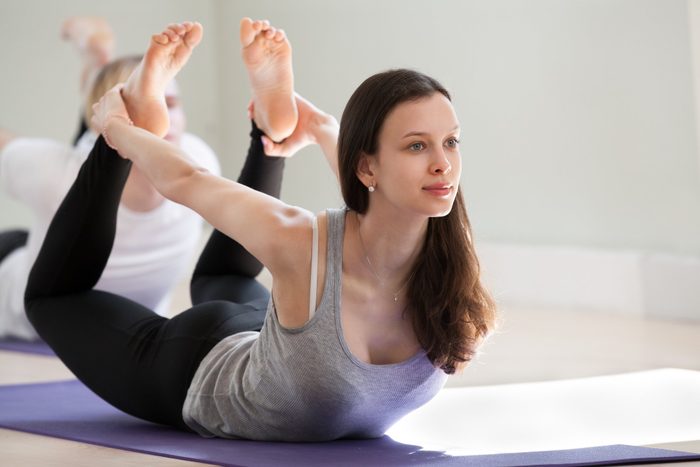
Bow Pose
Lie on your belly with your hands alongside your torso, palms up. Inhale as you lift your chest, head, and the tops of your ribs off the floor; exhale. On your next inhalation, lift your legs off the floor. Rock back and forth to gently massage your abdomen, says Gans. Hold for 20 to 30 seconds.
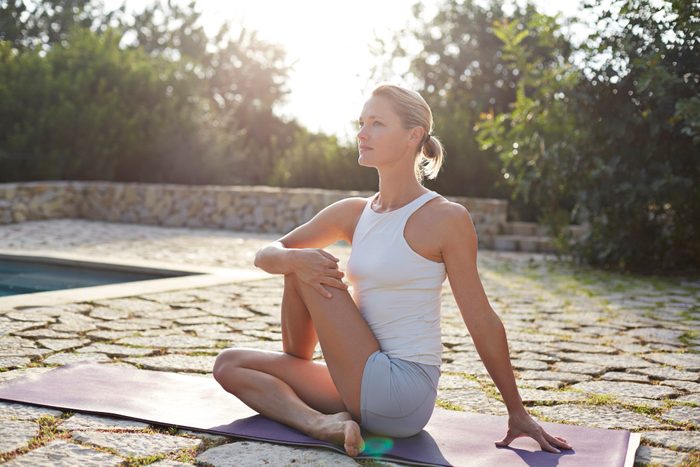
Seated Twist
Much like a wet towel, the Seated Twist works to “wring out” any air trapped within the abdomen while improving blood flow to vital organs. Start by sitting on the floor, legs outstretched. Bend the right knee and bring your right leg over the left, resting the foot just to the outside of the left thigh. Turning your torso toward your bent leg, bring the right arm around the right knee, inhale to lengthen the spine, and twist the body away from the leg. “Twist further on the exhale so that you’re working another part of your abdomen,” suggests Gans. For a modified version, sit upright in a chair and point both legs in one direction. Turning your torso in the opposite direction, use your hands to grip the back of the seat, slowly twisting. You can also try the reclining twist.
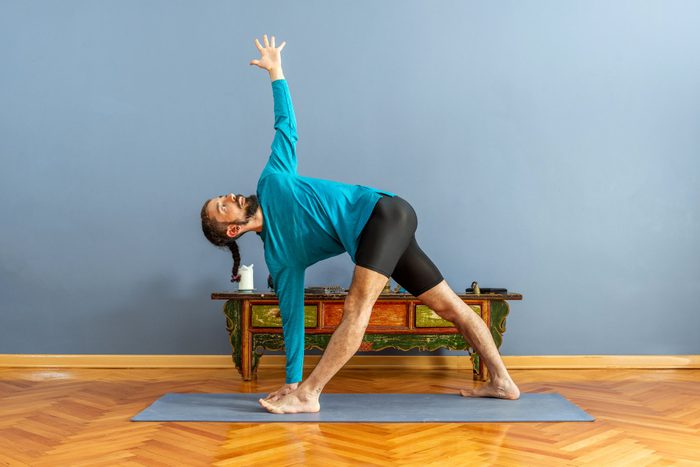
Revolved Triangle
The Revolved Triangle is “another form of a twist,” notes Gans. “It encompasses your total abdominal area.” Begin in a lunge with your right foot forward. Straighten your front leg and hop your back foot in to place your heel on the ground. Place your left hand on the floor or a block, to the inside of your right foot. Place your right hand to your right hip, keeping your right hip behind you. Extend the crown of your head forward, then turn your torso toward your right leg. Lift your right arm toward the ceiling. Keep rooting down through your left heel and turn your gaze to the ceiling. Hold for 5-10 breaths, then release back to the lunge. Repeat on the other side.
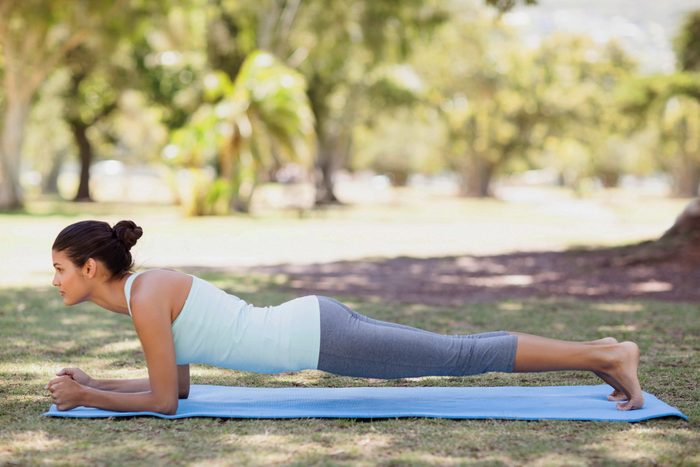
Plank
Begin in a push-up position, face down, with your forearms and toes on the floor. Your elbows should be directly under your shoulders and your forearms facing forward. Engage your abdominal muscles, drawing your navel toward your spine. Keep your torso straight and your body in a straight line, head to toe. Your heels should be over the balls of your feet. Hold for one to four breaths, then release to the floor. “If you’re doing the plank correctly your should feel it in your abdomen, not your shoulders,” says Gans. “Make sure your butt isn’t too high or sagging toward the ground. The strength should be coming from your core.” Check out these harder-working plank variations, courtesy of Jillian Michaels.

Deep Breathing
It sounds simple, but this is actually the most important move of them all. Yoga is all about connecting with the breath, and the simple act of deep breathing exercises can work to help reduce stress and anxiety, which some researchers believe may directly affect your digestive functions. This exercise is ideal for anyone looking to unwind or center themselves, and can easily be practiced pretty much anytime, anywhere. Sit in a comfortable position, soften the face, close your eyes, and alternate inhaling to four counts, then exhaling to four counts. Keeping your spine elongated (you can imagine a string pulling you upward from the top of your head). “Nothing works wonders more than a deep breath,” says Gans, who recommends adding a mantra for extra de-stressing benefits. “Pick a word or phrase that has meaning to you, such as ‘Let’ on the inhale and ‘Go’ on the exhale.”
Next, learn why you’re bloated to begin with and more ways to beat it.
